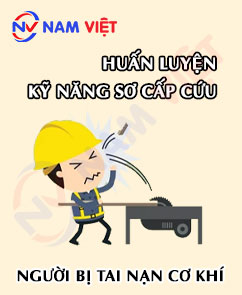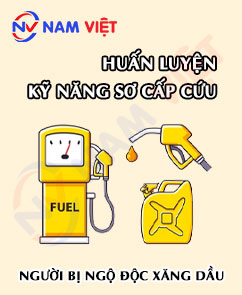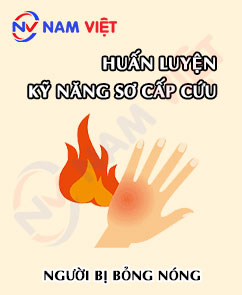First aid training for individuals with dislocated joints
500,000 ₫
Note: The above price is calculated per person. Prices may vary depending on the number of participants in the course and market fluctuations. For more accurate pricing, please refer to the price list or contact our consulting staff directly.
Table of Contents
Toggle1. Identifying a Person with a Dislocated Joint
a. Cases of people with dislocated joints
Dislocations can occur due to various reasons, including overexertion, trauma, or joint diseases. Here are some common cases:
- Shoulder dislocation: Occurs when the shoulder joint loses its normal position. It can happen due to trauma, overuse, or looseness of the joint. The victim may experience pain, limited mobility, and a cold sensation around the shoulder area.
- Elbow dislocation: Happens when the elbow joint is displaced from its normal position. This is often a result of trauma or overextension. The victim may experience pain, swelling, and difficulty moving the fingers.
- Wrist dislocation: When the wrist joint is dislocated, the victim may experience pain, swelling, and difficulty moving the wrist. Trauma or strong impact to the wrist can cause this condition.
- Hip dislocation: Occurs when the hip joint loses its normal position. This can be due to trauma, joint disease, or improper movement. The victim may experience pain, difficulty moving, and instability in the hip area.
- Knee dislocation: Occurs when the knee joint is displaced from its normal position. It can result from trauma, overloading, or joint disorders. The victim may experience pain, swelling, and limited knee mobility.

b. Signs indicating someone is about to dislocate a joint
There are several signs that can help recognize if a person is about to experience a joint dislocation. Common signs include:
- Pain: The victim may complain of pain or point to the affected joint. Pain can range from mild to severe depending on the severity of the dislocation.
- Swelling: The area around the joint may swell due to inflammation and the body’s response.
- Loss of mobility: The victim may have difficulty or be unable to move the affected joint due to pain, swelling, or instability.
- Difficulty using the joint: The victim may find it hard to use the dislocated joint, with limited or impossible movement.
- Instability: The victim may feel the joint is unstable or lacks normal support.
- Skin color changes: The area around the dislocated joint may change color, turning red or bluish.

c. Assessing the condition of a dislocation victim
Note that assessing the condition of a dislocation victim is the responsibility of medical professionals. However, some common situations include:
- Simple dislocation: The joint loses its normal position but can return automatically after minor manipulation. The victim may experience mild pain, slight swelling, and retain normal mobility.
- Dislocation that does not self-correct: The joint is displaced and cannot return to its normal position on its own. The victim experiences pain, swelling, and limited or no joint movement.
- Prolonged dislocation: The joint is displaced and cannot return to its normal position without professional medical intervention. The victim experiences pain, swelling, and inability to move the dislocated joint.
- Recurrent dislocation: The joint has been reduced back to its normal position but is prone to dislocate again after a short period. The victim may experience pain and instability around the joint.

d. Golden time for dislocation cases
The golden time for dislocation cases is crucial to ensure recovery and minimize possible complications. The golden time refers to the maximum period during which proper intervention should be performed after the dislocation occurs. It can vary depending on the type of dislocation and emergency priority. Some reference times for common cases include:
- Immediate intervention: Cases requiring immediate action include dislocations of the wrist, knee, and hip. Early and proper joint reduction is essential to minimize damage and ensure optimal recovery. The golden time in these cases may range from a few minutes to one hour after dislocation.
- Intervention within a few hours: Other dislocations, such as fingers, shoulder, and elbow, may require intervention within a few hours to increase the likelihood of successful joint reduction.
However, it is important to seek medical assistance immediately after a dislocation occurs for timely diagnosis and treatment. In such situations, call emergency services or take the victim to the nearest hospital for professional care.

2. Overview of First Aid Training for Dislocation Cases
a. What is a first aid training course?
A first aid training course is a program designed to teach learners basic and advanced first aid skills. The program includes lessons and practical exercises on handling emergency situations such as cardiac arrest, respiratory failure, poisoning, injuries, and other urgent scenarios.
The goal of the course is to equip learners with the necessary skills to respond to emergencies, minimize harm to themselves and others, increase survival chances, and ensure timely transfer to medical facilities.
REGISTER FOR BASIC FIRST AID TRAINING
b. Training duration
Initial first aid training:
- For employees: 4 hours.
- For first aid and emergency responders: 16 hours (2 days).
Periodic first aid training:
- For employees: 2 hours.
- For first aid and emergency responders: 8 hours (1 day).
c. Course content
- Basic principles of first aid and on-site emergency care
- Wound bandaging (principles, tools, techniques)
- Temporary bleeding control techniques (principles and methods)
- Temporary fracture stabilization techniques (principles and tools)
- Cardiopulmonary resuscitation (recognizing signs of cardiac arrest, airway clearance, breathing support, CPR guidance)
- Burn management (assessing cause and severity, on-site first aid)
- Safe victim transportation with and without stretchers for initial care
- Specific emergency care scenarios:
- Electric shock
- Drowning
- Chemical accidents
- General guidance on first aid kit use
- Practical exercises for all content areas
d. First aid training certificate
Upon completing the course, learners will receive a certificate confirming their completion of the first aid training program under the Group 2 training framework as specified in Appendix IV, Decree 44/2016/ND-CP. The certificate is valid for 1 year.


3. Essential items in a First Aid Kit for Dislocation Cases
For a first aid kit for dislocation cases, it is recommended to prepare the following tools and items:
- Medical gloves: To ensure hygiene and prevent infection, medical gloves should be included in the first aid kit.
- Rigid splints: Hard splints or wooden boards can be used to stabilize the dislocated joint before taking the victim to a medical facility.
- Clean cloth or fabric: Used to wrap around the dislocated area to keep the joint stable and reduce injury.
- Ice pack: Particularly useful for swelling and pain, ice packs help reduce inflammation and alleviate discomfort in the dislocated joint.
- Gauze and adhesive tape: Used to bandage or wrap the dislocated joint after it has been reduced or stabilized.
- Saline solution: Can be used to clean wounds or rinse the dislocated joint.
REGISTER FOR BASIC FIRST AID TRAINING
4. First Aid Procedure for Dislocations
Below is a basic first aid procedure for someone with a dislocated joint. However, please note that first aid is only a temporary measure and professional medical care must be sought immediately:
- Ensure safety: First, ensure the safety of the victim and the surrounding environment. Check for any ongoing risks that may cause further injury or serious accidents.
- Call for help: Call emergency services or request medical assistance immediately. Clearly explain the condition of the person with the dislocation.
- Pain relief and keeping calm: Help the victim stay comfortable and reduce pain by asking them to remain still and avoid moving the dislocated joint.
- Inspect and assess: Examine the dislocated area and assess the severity of the dislocation. Avoid moving the joint unnecessarily.
- Record the time: Note the time the dislocation occurred to provide important information to medical personnel.
- Immobilize the dislocated joint: Use a rigid bandage or splint to immobilize the joint, limiting movement and reducing pain.
- Relocate the joint (if trained): Only trained professionals should perform this step. Do not attempt to relocate the joint if you lack the necessary skills and knowledge.
- Cold therapy and swelling reduction: Use an ice pack or cold compress to help reduce swelling and pain. Apply for a short period of time.
- Documentation and monitoring: Record important information such as the time of dislocation, symptoms, and the first aid process.
5. Benefits of First Aid Training
First aid training provides many important benefits for individuals and communities:
- Saving lives in critical situations: First aid skills enable trainees to save someone whose life is at risk, such as in cases of cardiac arrest, respiratory arrest, poisoning, injuries, and other emergencies.
- Helping others learn first aid: Trained individuals can share their knowledge and experience with others, helping the community protect itself and reduce mortality in emergency situations.
- Reducing rescue waiting time: Trained first aiders can handle emergencies on-site, minimizing the time waiting for rescue teams to arrive.
- Enhancing response and reducing stress in emergencies: First aid training helps learners respond accurately and quickly, reducing pressure and anxiety while waiting for help.
- Increasing survival rates and reducing fatalities: Timely and proper first aid increases survival chances and reduces the risk of complications or death in emergency situations.

6. First Aid Training Capacity of An Toan Nam Viet
An Toan Nam Viet is a reputable and high-quality first aid training center in Vietnam. It conducts continuous training sessions at manufacturing workshops, factories, and construction sites nationwide (all 63 provinces of Vietnam).
REGISTER FOR BASIC FIRST AID TRAINING
Training Certification
- An Toan Nam Viet has been inspected and certified by the Department of Safety under the Ministry of Labor – Invalids and Social Affairs, granting certification to conduct occupational safety and hygiene training. Within the Group 2 training program, the first aid skills module is included, further strengthening our capacity in first aid training.

Training Materials and Lectures
- Before first aid training materials are used in first aid courses, they are reviewed to ensure accuracy and practical effectiveness.
- Instructors’ teaching methods are standardized according to An Toan Nam Viet standards, developed by experts in first aid training to maximize knowledge retention for trainees.
Facilities
- Controlling factors in the training room enhances teaching efficiency and knowledge absorption.
- Our training facilities provide spacious classrooms meeting standards for space, lighting, and training equipment, etc.
7. Nationwide First Aid Training Centers
An Toan Nam Viet is one of the most reputable and professional organizations for first aid training in Vietnam. With experienced instructors, modern equipment, and high-quality programs, the center has become an ideal destination for those interested in protecting lives and health.
By participating in courses at An Toan Nam Viet, you will learn basic and advanced first aid skills, including CPR for cardiac arrest, respiratory arrest, poisoning, injuries, and other emergency situations. The program is flexible and suitable for all learners, from adults to children, medical staff, rescue personnel, and the general public.
An Toan Nam Viet’s first aid training not only teaches essential life-saving skills but also fosters awareness to protect your own life and health as well as those around you. Training by experienced and highly qualified instructors ensures confidence and readiness for any emergency situation.
Register for first aid courses at An Toan Nam Viet to protect your life, health, and the community.
1 review for First aid training for individuals with dislocated joints
No comments yet












maituyet.cuong12
Good first aid training center! Satisfied